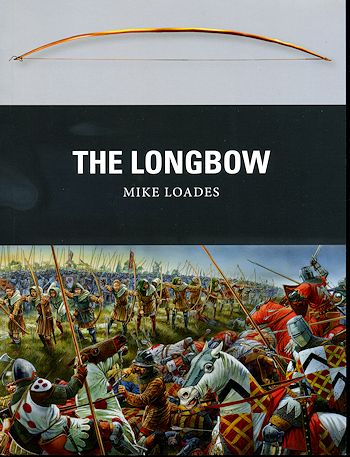 When this
series first started, one of the weapons I almost immediately thought about was
the longbow. Not that I have a passion for it or anything, but burned into my
memory are images of archers in battle and besides, I grew up on Robin Hood
watching it on TV when I lived in the UK during the 50s.
When this
series first started, one of the weapons I almost immediately thought about was
the longbow. Not that I have a passion for it or anything, but burned into my
memory are images of archers in battle and besides, I grew up on Robin Hood
watching it on TV when I lived in the UK during the 50s.
Well finally we have a book on it and it was well worth
the wait. The long bow is not a compound bow as you see today, but a simply
section of wood, more often than not ash or yew, that is bent by the attachment
of line from its ends. These bows are measured in the amount of force it takes
to pull back the bow string. Figuring out what these were like was not the
easiest thing as being wood, they tend not to last long once no longer used. It
is thanks to the restoration of the Mary Rose, a ship from the time of Henry
VIII that we have gotten to see preserved bows and arrows, something else that
rarely lasts the centuries intact. Arrow heads are not a problem, but the rest
of the system is.
Anyway, it has been determined that the force required
to pull back on the bowstring increased as the defensive armor of the opposition
increased. It started around 70-80 pounds of force and worked its way up to
90-100 with some bows being in the 120-130 pound category, though those were few
and far between as it takes a lot of strenth to bend a bow of that size.
The author is quite knowledgeable on the subject and is
able to take us through the history of the weapon as well as its manufacture as
well as the manufacture and care of arrows. I found it most interesting that in
England, being able to operate a bow and arrow was required by law. Undoubtedly
to provide a method of defense against the enemy (at this time that would be the
French), in case of invasion. Archers were also very well paid for the time as
the English army used a lot of them and most consider the English archers of the
time to be the best in the world.
The book goes into the offensive and defensive use of
the long bow, the development of armor to ward against it and its use in several
period campaigns. It also covers the use of archery at sea, an area where it was
most useful. In fact, the development of fire arms did not mean the end of the
long bow as the hitting power was comparable and an archer could lease many
arrows in the time it took to reload period guns. The conclusion that the author
comes to regarding the actual effectiveness of the longbow is one that I would
not have thought of, and will probably come to be a bit of a surprise to most
readers. In all, it is an outstanding addition to this series and a book I most
highly recommend to you.
October 2013
For more on the complete line of Osprey books,
visit www.ospreypublishing.com
or contact them at Osprey Direct, PO Box 140, Wellingborough, Northants,
NN8 2FA, UK. In the US, it is
Osprey Direct at 44-02 23rd St, Suite 219, Long Island City, NY 11101., where you can
get a catalogue of available books.
If you would like your product reviewed fairly and quickly, please
contact
me or see other details in the Note to
Contributors.
 When this
series first started, one of the weapons I almost immediately thought about was
the longbow. Not that I have a passion for it or anything, but burned into my
memory are images of archers in battle and besides, I grew up on Robin Hood
watching it on TV when I lived in the UK during the 50s.
When this
series first started, one of the weapons I almost immediately thought about was
the longbow. Not that I have a passion for it or anything, but burned into my
memory are images of archers in battle and besides, I grew up on Robin Hood
watching it on TV when I lived in the UK during the 50s.